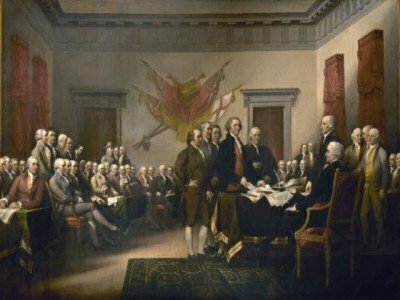Was the Constitution really written on hemp paper and where did Thomas Jefferson sign it? In honor of National History Day, Constitution Daily clears up some pesky myths from the Founding Fathers’ time.
 National History Day is a contest involving more than 500,000 students across the country. The Philadelphia version concludes today, and there is a lot of talk in our building about what is history and what are some common myths.
National History Day is a contest involving more than 500,000 students across the country. The Philadelphia version concludes today, and there is a lot of talk in our building about what is history and what are some common myths.
For example, did you know there were 12 colonies, and not 13 colonies? Technically, Delaware was considered a lower section of the colony of Pennsylvania until it left to become an independent state in 1776.
But let’s get back to the first two stories above, and start busting some Founding Fathers myths.
First, the Constitution wasn’t written on hemp paper. And neither was the Declaration of Independence. The two great documents were written on parchment. The point of debate is that some working drafts of the documents might have been composed on paper made from hemp, which was widely used in that time period.
Second, Thomas Jefferson didn’t sign the Constitution. This is the most –popular myth at the National Constitution Center, especially when guests enter our hall of statutes of the Constitution’s signers – and ask where the Jefferson statue is. In 1787, Jefferson was in Paris as the United States’ envoy, and he missed the Constitutional Convention in Philadelphia.
Third, Paul Revere probably didn’t say, “The British are coming” to warn the Patriots outside Boston. There is a lot about the Paul Revere myth that doesn’t ring true. For starters, Revere was on a secret mission to warn the Patriots about the advance of British forces, and at the time, the colonists were British. His more likely response was, “The regulars are coming out.” And Revere didn’t ride alone. There were multiple riders as part of the intelligence effort set up by the Patriots. In fact, Revere never reached Concord as part of the ride. He was detained by the British after leaving Lexington. It was another rider who rode from Lexington to Concord.
Fourth, the Fourth of July is the day the Founders signed the Declaration of Independence. On July 2, 1776, the Continental Congress agreed to break away from the British. On July 4, the Congress formally adopted the Declaration of Independence. On July 8, 1776 Colonel John Nixon of Philadelphia read a printed Declaration of Independence to the public for the first time on what is now called Independence Square. But the Declaration wasn’t signed by most of the delegates until August 2, 1776.
Fifth, The Founders wanted the turkey as our national symbol, and not the eagle. While turkeys clearly had one fan among the Founders, Benjamin Franklin, it appears that the birds weren’t close to challenging the eagle as the nation’s proud patriotic symbol. The real debate over the Great Seal started in 1776 and it lasted six years. Franklin’s idea was a design that featured a Biblical scene featuring Moses and Pharaoh. Jefferson wanted a scene depicting the children of Israel and two Anglo-Saxon mythical figures, and John Adams wanted another mythical figure: Hercules. Eventually, the eagle won out as the national symbol.
Sixth, George Washington had wooden teeth. Research performed on a set of Washington’s dentures in 2005 showed they were made of gold, ivory, lead, and human and animal teeth.
Seventh, the Liberty Bell rang after the Declaration of Independence was signed on the Fourth of July in 1776. Historians doubt this, since the steeple that housed the bell was rotted at the time. The myth was the result of a fictional story written years later in a children’s’ book.
Eighth, here is the deal with Delaware: Until 1776, Delaware was legally part of Pennsylvania and it was called the lower counties of the colony of Pennsylvania. It had its own legislature but the same colonial governor oversaw Pennsylvania and the Delaware region.
On June 14, 1776, the Colonial Assembly declared the region as separate and independent from Great Britain, and it became the first state – less than a month before the Continental Congress approved the Declaration of Independence.






